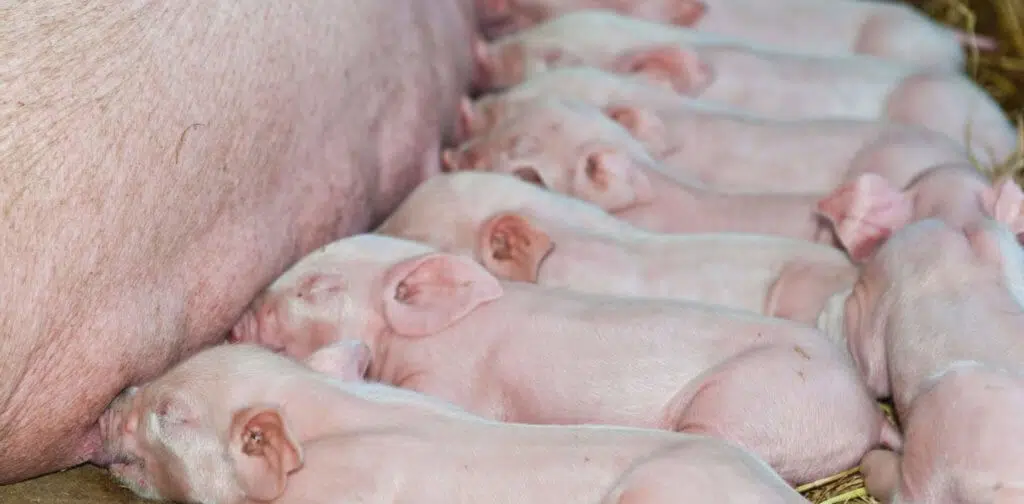Management and nutritional interventions can help swine producers reduce the economic consequences of low birth weight piglets, according to Zinpro Corporation, who hosted two webinars recently looking at the latest research in this area. Setting the scene, Dr Christof Rapp, a swine nutritionist with Zinpro, commented that low birth weight piglets are a consequence of genetic progress and increasing litter size.
“As litter size increases, we see a higher proportion of low birth weight pigs, which are associated with increased neonatal mortality and reduced growth rates. Birth weight is a major driver of returns. An extra 100 g/piglet birthweight translates to an extra 42 kg when the piglet reaches slaughter weight, so the more we can do to increase body weight at birth and also increase the survivability of low birth weight piglets, the better the economic returns can be.”
Dr Christoff Rapp
There is a strong correlation between litter birth weight and survival. Dr Marrina Schuttert, a swine practitioner at de Varkenspraktijk, Someren, The Netherlands illustrated this point with an extensive dataset that showed 15% of pigs had birth weights lower than 1.1 kg. This subpopulation of pigs had a 34% preweaning mortality rate and represented 43% of total preweaning mortalities and a significant economic drain.
Dr Anja Varmløse Strathe, Assistant Professor in the Department of Veterinary and Animal Sciences at Copenhagen University, explained that sow nutrition plays a fundamental role in piglet birth weight, commenting that within-litter variation in foetal weight is apparent as early as day 28 of gestation. Dr Varmløse Strathe has carried out studies in Denmark to examine the impact of changed feeding in early gestation on piglet birth weight and reducing the within-litter variation in birth weight. She says early indications are that the addition of omega-3 fatty acids and antioxidants can increase birth weight.
“There are a number of nutritional factors in the sow related to smaller piglets. The sow may be lacking in key nutrients including amino acids, vitamins, trace minerals, and fatty acids, while some harmful substances, such as free radicals producing during oxidative stress, can have a negative effect. For example, a shortage of arginine and methionine has an impact on vascularisation and development of the placenta. Small foetuses are associated with smaller placentae. Omega-3 fatty acids are known to have an effect on the sow’s immune system and also on the development of the foetal nervous system and vision, leading to piglets with better cognitive abilities at birth which can contribute to higher survival. Increasing the supply of anti-oxidants including vitamin C, zinc, and selenium help reduce the negative effects of oxidative stress which include reduced placental development.”
Dr Anja Varmløse Strathe
Oxidative stress is known to have negative effects on oocyte maturation and embryo development. In a trial in a commercial herd in Brazil, Dr Rapp explained that a proportion of inorganic minerals was replaced with Availa® Sow, which utilises a unique pathway for absorption – the amino acid transporter – allowing for exceptional uptake. Once in circulation, Zinpro Performance Minerals® are metabolised differently from other metal sources allowing animals to utilise the trace minerals more effectively.
By improving the quality of trace mineral supply, it was possible to reduce the impact of oxidative stress. The result was an increase in total litter birth weight and a higher proportion of heavier piglets born.”
Dr Christoff Rapp
While interventions will help to reduce the incidence, piglets with a low birth weight are likely to remain a fact of life on swine units. Dr Marrina Schuttert explained it is still possible to manage these piglets in order to increase their chances of survival and finishing. In addition to nutritional aspects, she emphasises the need to reduce the incidence of infectious disease in sows, take measures to reduce temperature-related stress, and ensure the availability of between 15 and 20 litres of clean water per sow per day. The farrowing room should be 22-24°C, and farrowing areas must be clean and dry.
While crushing is usually the main quoted cause of death in less viable piglets, it is not the ultimate cause of piglet death. It is the effect of perinatal hypothermia and starvation. Undernourished piglets spend more time close to the sow and so are more likely to be crushed. Furthermore, starvation interacts with the effects of perinatal hypothermia, making piglets more lethargic, less competitive at the udder, and less likely to achieve a sufficient colostrum intake. The lower critical temperature of newborn piglets is 34°C and when the ambient temperature is below this, piglets will attempt to gain heat shivering and huddling together.
Dr Marrina Schuttert
She emphasizes the need to ensure sufficient colostrum intake or around 200 g to 250 g per piglet. Piglets consuming less than 200 g have a 46% higher mortality. The challenge is in the distribution of colostrum between piglets, especially as immunoglobulin levels drop by 50% in the first six hours after farrowing. A piglet’s survival depends on getting access to colostrum, so consider split-suckling piglets so they can all get access to the udder.
Conclusion
Summarising the webinars, Dr Rapp said management and nutritional interventions at both the sow and piglet level can help reduce the number of low birth weight piglets and increase the chances that those born are able to survive and finish. Together this will help producers to achieve higher returns from hyper-prolific sows.
You can also read more about giving piglets a healthy start to life in this article by Mashilo Phosa, the swine team lead at Chemuniqué.
Chemuniqué empowers feed and food producers with the most innovative animal performance solutions, enabling our clients to consistently advance the efficiency of production.









